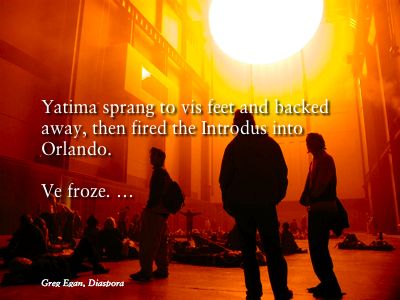
I was trying to find an image of a burning sun, dead fleshers, the end of civilisation, and a few robots standing around. For some reason I thought of Olafur Eliasson’s Weather Project at the Tate Modern a couple of years ago. This is one of my own projects.
“Yatima sprang to vis feet and backed away, then fired the Introdus into Orlando.” (Yatima is the software human in the robot body, and he’s uploading the consciousness of the dying flesh human, Orlando, so he too can live in the software cities they inhabit.)
“Ve froze. The wall had struck an obstacle; it was tilted precariously, but holding. Waves of nanoware were sweeping through Orlando’s body, shutting down nerves and sealing off blood vessels to minimise the shock of invasion, leaving a moist pink residue on the rubble as flesh was read then cannibalised for energy. Within seconds, all the waves converged to form a grey mask over the face, which bored down to the skull and then ate through it. The shinking core of nanoware spat fluid and steam, reading and encoding crucial synaptic properties, compressing the brain into an ever-tighter description of itself, discarding the redundancies as waste. Inoshiro stooped down and picked up the end product: a crystalline sphere, a molecular memory containing a snapshot of everything Orlando has been.”
Awesome. The ‘vis’ is interesting. It’s a gender-free pronoun. Software humans choose and can change their sex.
But wow! In Neuromancer, you just wear a sweatband that plugs into some dermatrodes that stick out of the temples and go the brain. But this: it’s pretty hardcore.
And, you know, that makes sense. The virtual threshold being crossed here is huge, and the physical should parallel that in magnitude. It’s like when a prince is crowned to become a king. Suddenly he will have powers to execute anyone, makes laws… everything changes. But it’s a virtual change. It’s still the same guy, right, with a hat on. To accompany this enormous virtual change, we realise it in something physical—crowds, ceremony, and ritual. We always do this: Porches signify the virtual threshold of stepping over into properties, that’s just an everyday case.
I don’t find William Gibson’s cyberspace sweatband believable. But Egan’s steaming, fluid-filled, fleshy description: it feels more true. This is something so important about sci-fi, the way the narrative holds itself up and creates a believable world through features like this. It’s not enough to have an artefact alone. In a way it’s like marketing, and the way it persuades by displaying self-complete narratives of cause and effect. There are features which are outside the main story, but are necessary for believability and for people to accept the narrative into their lives.
We’ll come back to Diaspora later.